The digital exhibition, Glamour and Innovation: The Women Behind the Seams of Fashion at the White House, is part of a new collaboration between NYU’s Steinhardt School of Culture, Education, and Human Development and the White House Historical Association.
The American public has long harbored a fascination with First Lady fashion. From Jackie Kennedy’s iconic ivory silk-taffeta wedding gown to Rosalynn Carter's scandalous rewearing of the same blue chiffon dress, the clothes of the White House’s leading ladies have a unique power to inspire trends, invite critique, and capture the nation’s attention.

L: Senator John Kennedy and Jacqueline Bouvier Kennedy at their wedding reception in Newport, RI. R: First Lady Rosalynn Carter wore this gold embroidered sleeveless coat over a gold-trimmed blue chiffon gown designed by Mary Matise for Jimmae a total of three times, creating a mini press scandal. Photo courtesy of the Smithsonian's National Museum of American History.
Fashion is a highly influential cultural product that has helped shape public understanding of America’s power, legacy, and evolving attitudes for centuries—and in the White House, simple fashion statements can take on outsized political and cultural significance. The choice to wear American-made dresses during the Great Depression in the 1930s helped Lou Henry Hoover communicate the importance of supporting the cotton textile industry in an ailing economy. The bubblegum pink shade preferred by Mamie Doud Eisenhower became known as “Mamie pink” and was worn by many women in the ‘50s and ‘60s. And Jackie Kennedy ushered in a new era of style, with her timeless Chanel suits, oversized sunglasses, and pillbox hats inspiring countless imitators.
But with the focus placed squarely on the powerful women in the clothes, less is known about the groundbreaking designers, seamstresses, and couturiers who worked behind the scenes to shape centuries of fashion—and White House—history.
These designers are the focus of the digital exhibition Glamour and Innovation: The Women Behind the Seams of Fashion at the White House, launching in June 2022 as part of a new collaboration between NYU’s Steinhardt School of Culture, Education, and Human Development and the White House Historical Association. As the association’s inaugural digital exhibition intern, NYU Steinhardt Costume Studies graduate student Maegan Jenkins collaborated with the David M. Rubenstein National Center for White House History and its digital library team to highlight the storied careers of eight women who created some of history’s most iconic outfits.
The exhibition is part of the association’s focus for 2022 on “White House Tastemakers and Trendsetters,” which encompasses a closer look at the cuisine, fashion, social traditions, and individuals who lived, visited, or worked in the White House and inspired or influenced American culture.
Jenkins’ exhibition will cover over a hundred years in fashion history, beginning with Elizabeth Keckley, Mary Lincoln’s dressmaker who was born enslaved, to the mysterious designer Mary Matise, who designed Rosalynn Carter’s 1977 inaugural ball gown. This digital exhibition features a mix of archival photographs, press clippings, portraits, and high resolution images that will allow virtual visitors to zoom in and examine these designers’ intricate craftsmanship—such as the 2,000 rhinestones hand sewn into Mamie Eisenhower’s inaugural gown.
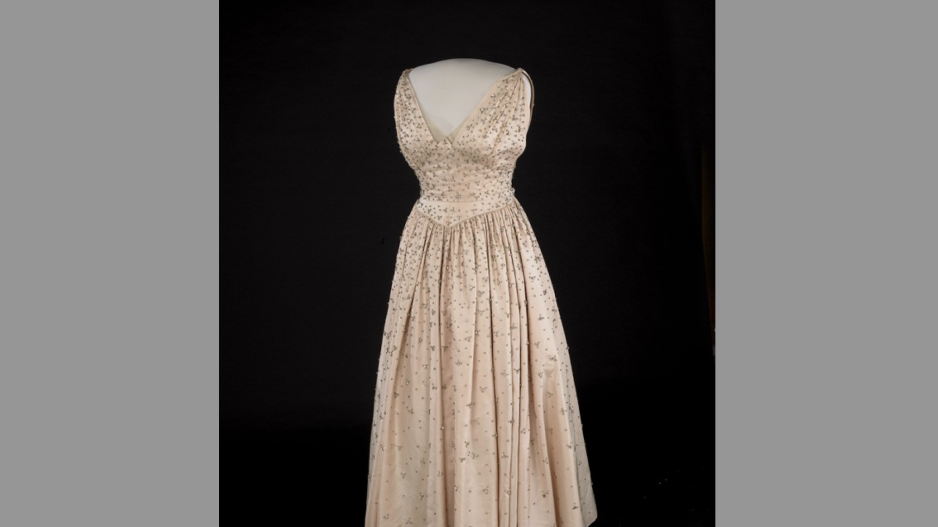
Mamie Eisenhower’s Inaugural Gown, 1953. Photo courtesy of the Smithsonian's National Museum of American History.
NYU News spoke to Maegan Jenkins about the intersection of fashion and social justice, and the historically underrepresented women who defined White House fashion in the 19th and 20th centuries: Elizabeth Hobbs Keckley, Mary Matise, Sally Milgrim (Eleanor Roosevelt), Nettie Rosenstein (Mamie Eisenhower), Ann Lowe (Jackie Kennedy), Ethel Frankau (Jackie Kennedy), Karen Stark (Pat Nixon), and Frankie Welch (Lady Bird Johnson, Betty Ford).
What drew you to White House fashion history?
I'm in a dual master's program in costume studies and library sciences. Before this, I was the resident costume designer for Soft Cage Films in Chicago, a production company known for short social justice films. I've always had this feeling about clothes and costumes—you can learn so much about how someone feels about themselves and the world and their place in it, just from looking at their clothes.
I've had this idea in the back of my head for a while. I really love creating costumes, but I want to go a little bit deeper. I want to discuss the theories behind the clothes. I want to talk about why certain styles and designers are revolutionary, why they're important, and how they change the narrative of fashion.
These days, we're always watching what the First Lady is wearing to inaugurations, when she's meeting the press, and when she's on tour. The emphasis is always on the design house or the big name designer, but this wasn't always the case. The eight designers I’m highlighting in the exhibition are all women that have been marginalized by society. Not all of them necessarily have marginalized identities but their stories and their histories have been lost. They have had an incredible impact on public discourse surrounding America’s most influential cultural figures, but they're not household names, nor are they recognizable by the broader public. A lot of them started out as dress makers. It’s so important to bring their stories to light.
Why did you choose to focus on these women in particular?
I wanted to cover a broad range of fashion history. I started with Elizabeth Keckley, who was Mary Todd Lincoln’s dressmaker. She's a really great starting point because her personal story is so interesting and rich. She was born enslaved, but she was so skilled at dressmaking that she was able to purchase freedom for both herself and her son. She navigated this complicated place of being Mary Todd Lincoln’s dressmaker, but also her confidante and friend. There are so many beautiful, handmade, hand-sewn garments made by Elizabeth Keckley. I came across a quilt, called the Keckley Quilt, made out of scraps from Mary Todd Lincoln’s dresses. It’s one of my favorite pieces in the exhibition. The quilt is visually stunning, but it also touches on ideas about sustainability that are prevalent in the fashion industry today, albeit in a very different way.
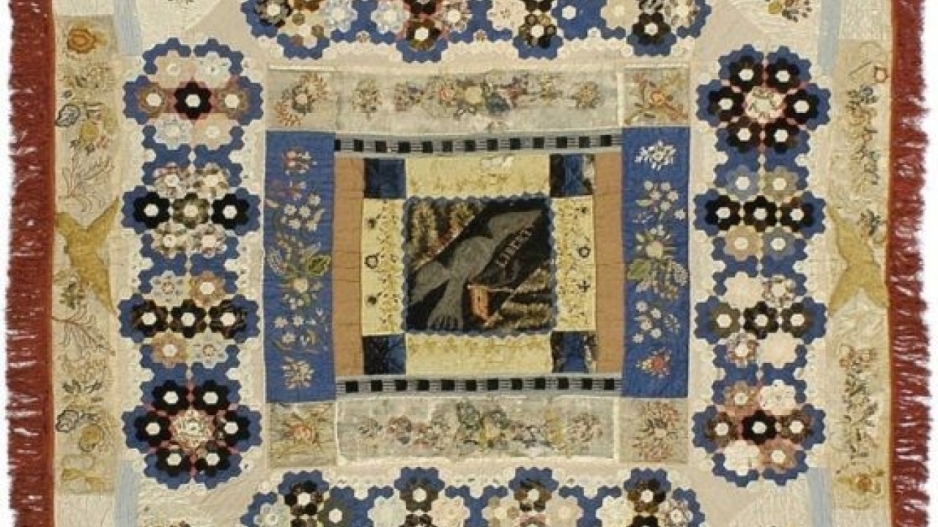
A quilt said to be made by Elizabeth Keckley from scraps of Mary Todd Lincoln's dresses. Photo courtesy of Kent State University Museum via the White House Historical Association.
The most recent designer that we're including is Frankie Welch. She's compelling because she was one of the first designers to design across the aisle, making dresses for First Ladies from both the Republican and Democratic parties, including Betty Ford and Lady Bird Johnson. This trend is much more prevalent with design houses today. She also instilled the idea of American pride into her designs. She created custom, hand-painted scarves—some for the White House that feature prominent political designs—that became a chronicle of American life.
I was interested in these particular designers because I hadn't heard a lot about them before and I’m someone who is interested in fashion history. I purposely stopped at Frankie Welch because afterwards it starts to shift a little bit more to design houses or big name designers that people have greater awareness of.
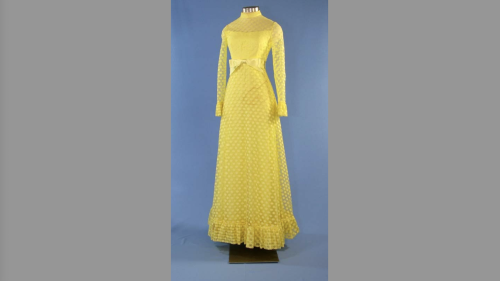
First Lady Betty Ford wore this lemon-yellow chiffon gown, designed by Frankie Welch for a state dinner with Prime Minister Yitzhak Rabin of Israel in September 1974. Photo courtesy of Ford Library Museum.
The most recent designer that we're including is Frankie Welch. She's compelling because she was one of the first designers to design across the aisle, making dresses for First Ladies from both the Republican and Democratic parties, including Betty Ford and Lady Bird Johnson. This trend is much more prevalent with design houses today. She also instilled the idea of American pride into her designs. She created custom, hand-painted scarves—some for the White House that feature prominent political designs—that became a chronicle of American life.
I was interested in these particular designers because I hadn't heard a lot about them before and I’m someone who is interested in fashion history. I purposely stopped at Frankie Welch because afterwards it starts to shift a little bit more to design houses or big name designers that people have greater awareness of.
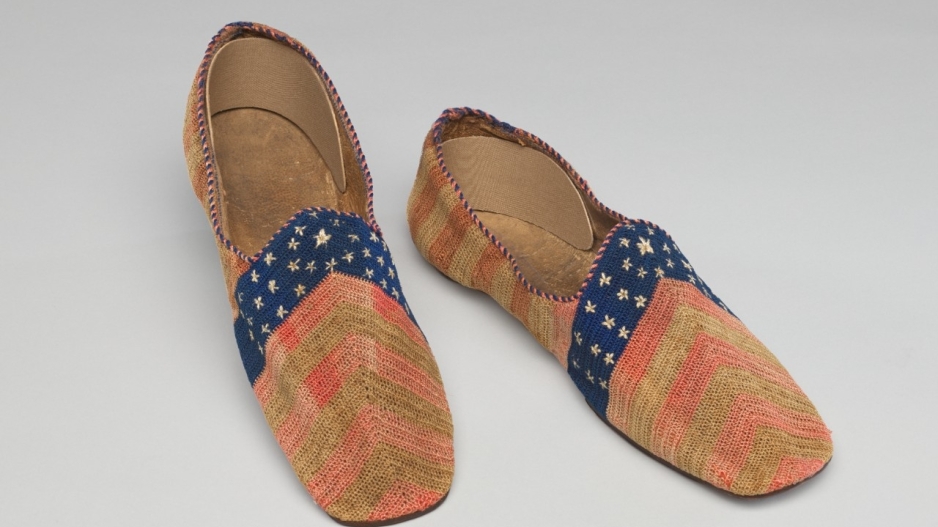
Pair of stars and stripes slippers attributed to Elizabeth Keckley. Photo courtesy of the Smithsonian's National Museum of African American History and Culture.
What was your experience like working with the White House archives?
I'm a visual person so I jumped right into the image archives. The White House Historical Association has wonderful archives and they also have access to other important collections. I've had the opportunity to work with the Smithsonian archives, the National Archives, and some of the presidential libraries. I uncovered a wealth of beautiful photography from fashion periodicals and beautiful detailed images of dresses, shoes, and like I mentioned, the quilt. It’s really important for me to include detailed images so the viewer can zoom in and get a good look at the surface design, including the hand-sewn stitches and intricate beading.
For example, Mamie Eisenhower's inaugural gown was created by Nellie Rosenstein and it has something close to 2,000 rhinestones beaded in the fabric. It’s such a breathtaking gown. It's really important to be able to see the sheer amount of effort and handwork that goes into creating such a beautiful gown for a prominent woman.
What have you discovered about fashion’s role in White House history and American culture?
I think it’s really important that we talk about the role of individual artisans that work in the White House. These women, from all different backgrounds and walks of life, had the opportunity to work with the White House, which is a position of extreme privilege. If that's not the American dream, then what is?
I’m interested in the intersection of social justice, fashion, and the individual. People like Elizabeth Keckley and Ann Lowe are good examples of that. Ann Lowe was groundbreaking as one of the first Black couturiers. The ivory silk taffeta wedding dress she designed for Jackie Kennedy is one of the best-known wedding dresses of all time, although she wasn’t publicly credited with the design at the time.
I like to examine the idea of women as makers and how design and fashion is the connective tissue for American visual culture. These designers are an example of that and offer a good opportunity to dig deeper into those themes. These women weren't working with big design houses; they were sewing things by hand and had few resources. Even so, their labor and craft had a lasting impact.
Can you give an example of this impact?
Jackie Kennedy’s wedding gown is very recognizable, as is her inaugural gown created by Ethel Frankau. It's interesting because Jackie Kennedy is widely recognized as the most stylish First Lady; she had a huge influence on fashion. In fact, I have asked a few people “who is the most stylish First Lady,” and their immediate answer was “Jackie Kennedy”. She was one of the people that really broke out and made a name for herself and she was so iconic because of it. It's almost as if the gowns or the garments that she was wearing took on a life of their own. American women adapted their own wardrobes to emulate her effortless style. Her look has had a lasting impact on American cultural memory but the designers who created her look aren’t widely known. I hope that visitors to the exhibition will leave knowing these women’s names that have been lost to history.
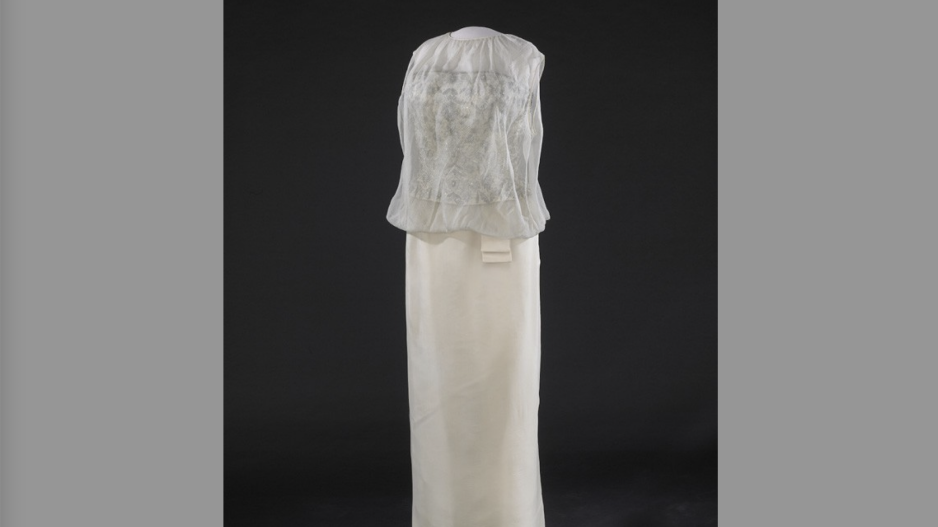
Jacqueline Kennedy’s inaugural gown, 1961, designed by Ethel Frankau. Photo courtesy of the Smithsonian's National Museum of American History.
